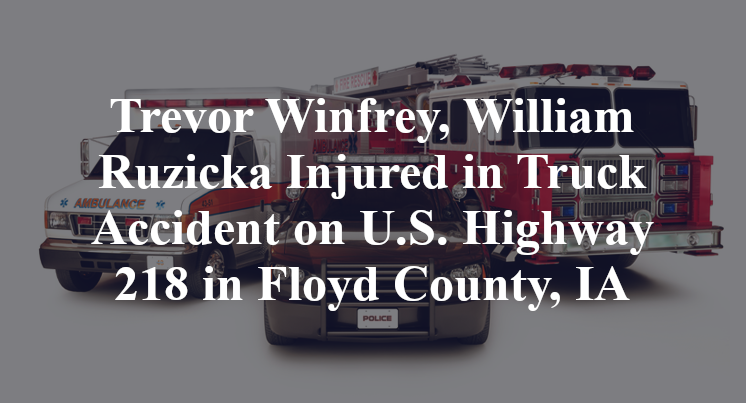Trevor Winfrey, William Ruzicka Injured in Truck Accident on U.S. Highway 218 in Floyd County, IA
Floyd County, IA — May 9, 2025, Trevor Winfrey and William Ruzicka were injured in a truck versus tractor accident shortly after 8:00 a.m. along U.S. 218.
According to authorities, 37-year-old Trevor Daniel Winfrey was traveling in a southbound Ford F-650 truck on U.S. Highway 218 when the accident took place.

Also traveling southbound at the time, according to reports, was a farm tractor occupied by 54-year-old William Joseph Ruzicka. The tractor reportedly had a planter in tow, as well. Officials indicate that, for as yet unknown reasons, a collision took place between the truck and the tractor's planter. The impact apparently caused the tractor to spin off of the roadway and into a ditch where it overturned.
Ruzicka and Winfrey both sustained injuries of unknown severity, reports state; they were each transported to local medical facilities by EMS in order to receive necessary treatment. Additional details pertaining to this incident are not available at this point in time. The investigation is currently ongoing.
Commentary by Attorney Michael Grossman
Crashes involving farm equipment on rural highways are often more complex than they appear, especially when a commercial truck is involved. From a legal perspective, the question is not just why did the truck hit the tractor's planter? but also whether the driver of the truck—and the company that put them on the road—were prepared to safely share that road with slow-moving agricultural vehicles.
In rural areas, tractors and farm machinery are a common and expected part of traffic. They move slowly, often take up more than one lane, and may make wide turns or have equipment—like planters—that extend well beyond the body of the vehicle. Commercial truck drivers operating on those roads are expected to anticipate those risks and allow for extra distance and time to react. If the truck struck the planter from behind, one of the first things to investigate is whether the driver was following too closely, distracted, or driving too fast for the conditions.
It's also important to ask whether the planter and tractor were properly marked and visible. Was there a slow-moving vehicle emblem on the planter? Were lights or reflectors present and working? Even though farm vehicles are slower and bulkier, they still have a duty to be visible and predictable. But that duty doesn't excuse a failure by a professional driver to identify and avoid a hazard that should have been obvious in daylight conditions.
And if the Ford F-650 was being used for commercial purposes, then the employer who owns or operates that vehicle has legal obligations, too. Was the driver trained to handle rural traffic scenarios? Did the company establish guidelines for operating near farm equipment? Was the truck in proper working order, including brakes and steering systems that would be needed for an emergency maneuver? I’ve seen cases where companies send drivers out on rural deliveries or routes with little to no preparation for the unique challenges they might encounter—this crash may be another example of that kind of oversight.
Getting to the bottom of a crash like this means asking the right questions and refusing to stop at surface-level explanations. Serious wrecks deserve serious investigation, not assumptions. Understanding whether the truck driver was alert and driving responsibly, whether the farm equipment was clearly marked, and whether the company behind the truck prepared its driver for this type of environment is key to figuring out what might have happened. Getting clear answers to these questions is the least that can be done to help those affected find the clarity and closure they deserve.

“These are essential reads for anyone dealing with the aftermath of a truck wreck”– Attorney Cory Carlson